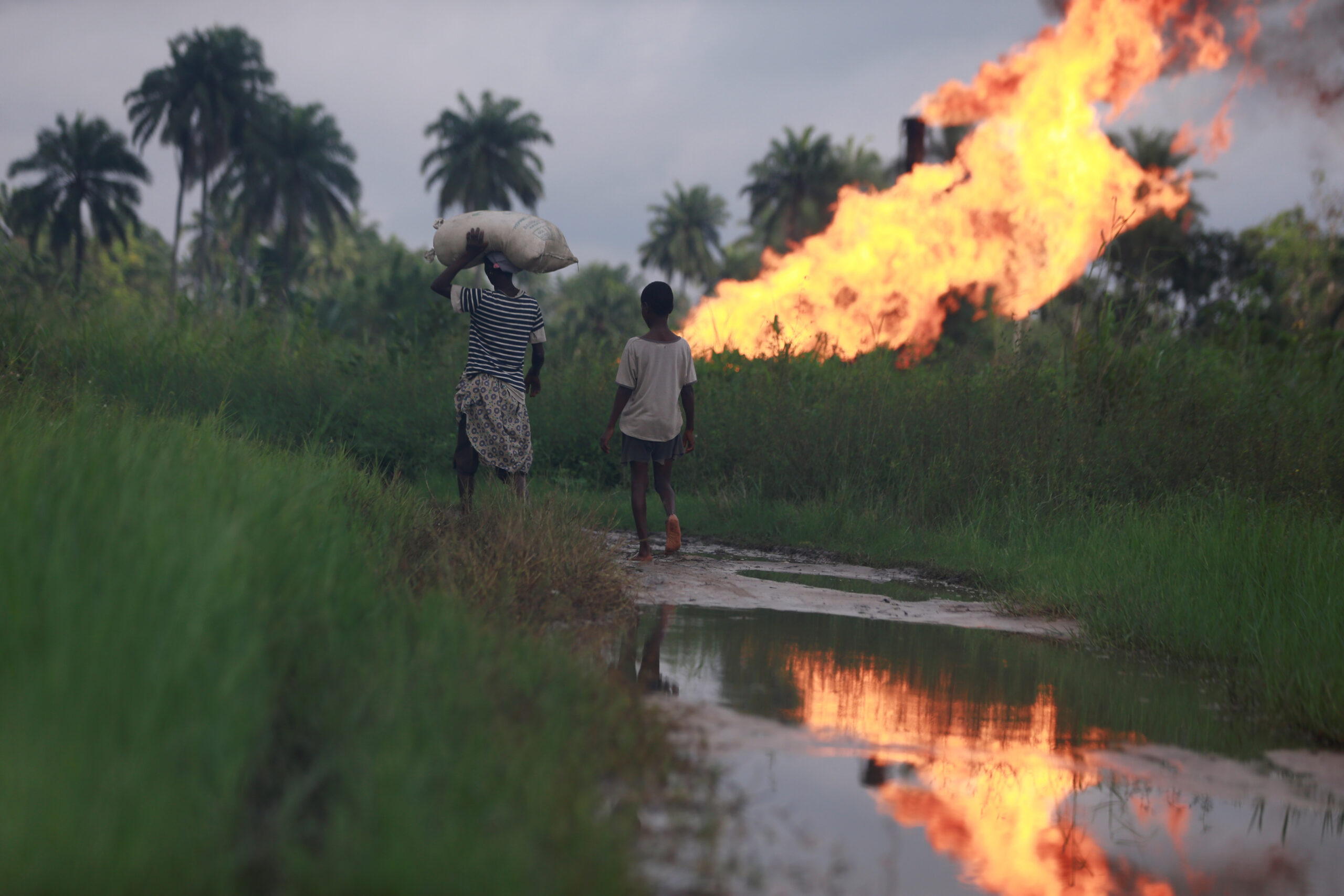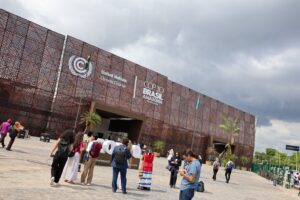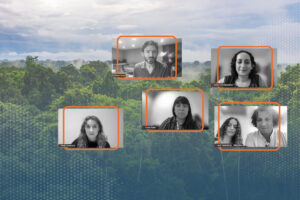Next week’s seventh meeting of the board of the Fund for Responding to Loss and Damage (FRLD) in Manila presents a critical moment for a course correction.
The fund’s establishment in 2022 was hailed by climate justice advocates. However, three years later, its operations and future are hampered by insufficient attention to human rights and the communities most impacted, as well as a severe lack of resources. Currently, less than 0,1% of the estimated funding needs are in the FRLD’s bank account.
Key items on the Manila meeting’s agenda, including the fund’s start-up phase and its long-awaited resource mobilization strategy, could change this. It’s also the first meeting since the International Court of Justice (ICJ)’s historic advisory opinion on the legal obligations of states in respect of climate change.
This authoritative legal opinion clarifies states’ loss and damage obligations and has significant implications for ensuring that the fund will effectively deliver resources at scale directly to communities on the frontlines of the climate crisis, in line with their right to remedy.
A long-awaited clarification
The advisory opinion comes with unparalleled legitimacy: all countries agreed through a consensus resolution by the UN General Assembly to ask the ICJ for guidance on their international legal obligations in the context of climate change.
Decades of foot-dragging and deliberate blockage under the climate regime have led to rapidly escalating climate harm. It’s therefore no surprise that the most climate-vulnerable countries, like small island developing states and their communities, led the charge on taking climate change up to the world’s highest court.
The importance of this ruling – an authoritative interpretation of binding international law – cannot be understated, particularly for loss and damage.
Legal obligation to remedy climate harm
The court strongly affirmed that climate harm – also known as loss and damage – is a reality that requires dedicated responses and finance as a matter of obligations, including within the climate regime. This is especially true for those most responsible for causing the crisis, in line with long-established principles of equity and Common But Differentiated Responsibilities.
The ICJ also affirmed loud and clear that human rights law is critical to interpreting and addressing loss and damage: not only is the climate crisis harming a wide range of fundamental human rights, but rights-based principles and standards are also fundamental to loss and damage responses.
Additionally, by looking at international law holistically, the court endorsed what grassroots movements have long known: frontline communities and countries have a right to full reparation.
The court confirmed the basic principle of international law that those who breach their legal obligations, including under the climate treaties, have a duty to repair the harm they cause. In explicitly recognizing legal consequences for “peoples and individuals”, the ICJ reaffirmed communities as direct rights-holders for such reparations.
How the fund should respond to ICJ decision
As board members consider the fund’s future, they must ensure that loss and damage responses are fully consistent with international law. This will be essential to overcoming longstanding impasses and to building an institution that is founded on justice.
First and foremost, states have a duty to provide resources at the scale of loss and damage needs, based on their Common But Differentiated Responsibilities. This has important implications for the upcoming resource mobilization strategy for the FRLD, both in terms of the scale that it needs to aim for – as needs are in the hundreds of billions – and how to reach it.
Rich nations accused of delaying loss and damage fund with slow payments
The board must move beyond voluntary contributions and periodic pledging conferences to clarifying differentiated obligations, with concrete pathways to make polluters pay and hold big polluters accountable.
Second, all those harmed by the climate crisis have a right to remedy – not charitable assistance. This has critical implications for decisions on access to the fund.
Bureaucratic rules and the limitations imposed by the World Bank as the FRLD’s trustee cannot stand in the way of all climate-vulnerable developing countries having direct access to the fund. Moreover, as the ICJ affirmed, the legal consequences of states’ wrongful acts extend to peoples and individuals, making direct community access a matter of right rather than discretion.
NGOs urge Brazil to prevent fossil fuel capture of COP30 climate summit
Third, international human rights law must guide loss and damage responses as a legal requirement, not as best practice. The fund’s start-up phase and long-term operations should recognize that losses and damages are, first and foremost, human rights violations and adjust accordingly.
Loss and damage needs assessments must explicitly include human rights criteria and non-economic loss and damage. The fund must urgently develop policies and do-no-harm frameworks that ensure inclusive, participatory, and accountable operations that protect ecosystems and human rights, including Indigenous Peoples’ rights.
‘There is no going back’
The momentum for climate justice needs to continue after the fund’s board meeting. At COP30 in Belém, Brazil, states are expected to finally deliver action consistent with their legal obligations on mitigation, adaptation and loss and damage.
Beyond COP30, the Pacific island nation of Vanuatu has announced its push for a new UN General Assembly resolution to endorse and operationalize the ICJ’s advisory opinion.
All states have agreed that guidance from the ICJ on legal climate obligations was necessary. Now, they must deliver urgent, tangible solutions for the communities most affected by the climate crisis. The legal landscape has shifted – there is no going back to a world where climate accountability can be evaded.
Liane Schalatek is associate director of the Heinrich-Böll-Stiftung in Washington DC. Lien Vandamme is a senior campaigner at the Center for International Environmental Law (CIEL). Monica Iyer is an assistant professor at the Georgia State University College of Law. Rajib Ghosal is an international consultant working on climate justice and development. Teo Ormond-Skeaping is a coordinator of advocacy and outreach at the Loss and Damage Collaboration. Isatis M. Cintron is a climate justice postdoctoral researcher and director of the ACE Observatory.
The post The ICJ climate ruling has major implications for the loss and damage fund appeared first on Climate Home News.
The ICJ climate ruling has major implications for the loss and damage fund
Climate Change
DeBriefed 14 November 2025: COP30 DeBriefed: Finance and 1.5C loom large at talks; China’s emissions dip; Negotiations explained
Welcome to Carbon Brief’s DeBriefed.
An essential guide to the week’s key developments relating to climate change.
This week
Finance and 1.5C dominate talks
AGENDA ADOPTED: Negotiations at the COP30 UN climate talks began in the Brazilian city of Belém this week, attended in person by Carbon Brief’s Daisy Dunne, Josh Gabbatiss and Anika Patel. The Brazilian hosts scored an unexpected early win by dodging an “agenda fight” over proposals to add various contentious issues to the official docket. Despite the neat footwork, four issues kept off the agreed agenda – climate finance; emissions reporting; trade measures; ambition and 1.5C – still loom large, having merely been diverted into “presidency consultations”.
PRESIDENCY PROMISES: By Wednesday, the presidency was promising “good news” at a plenary later that day, which had been due to offer an update on progress with the four extra items. Instead, it ended abruptly, with COP30 president André Corrêa do Lago promising to say more at another plenary scheduled for tomorrow. It remains unclear how the presidency intends to deal with these thorny issues, leaving the COP rumour-mill in full swing.
MINISTERIAL MAGIC: Aside from the extra issues, the official agenda at COP30 already has more than 100 items to contend with, including how to track progress on adaptation and how to ensure a “just transition” as emissions-cutting measures are implemented. (You can follow them all via the Carbon Brief text tracker.) While draft texts have started to emerge, many items remain stalled, with persistent divisions along familiar lines (see below). Negotiators will be hoping that ministers arriving over the weekend are primed to unlock progress. Brazil has appointed pairs of these politicians to push for deals in key areas.
Around the world
- Ethiopia has said it will host COP32 after beating out a bid from Nigeria, Reuters reported. Turkey and Australia are still in deadlock over who should host COP31, with a decision due by the end of these talks, BBC News reported.
- China will not contribute to Brazil’s Tropical Forest Forever Facility, Bloomberg reported, while Devex said two multilateral development banks are considering paying in. More than $5.5bn has been pledged so far, which BusinessGreen noted is “well short” of a $25bn target. The fund was labelled a “false solution” by some Indigenous and civil society groups.
- After Brazilian president Luiz Inácio Lula da Silva called for a “roadmap” away from fossil fuels ahead of COP’s opening, rumours are swirling over how this might take shape. A new declaration spearheaded by Colombia and a roadmap with backing from a number of countries, including Denmark, the UK, France, Kenya and Germany, are being floated as possible options.
- China is currently among the countries pushing for “provision of finance from rich countries and unilateral trade measures” to be included on the agenda, reported Climate Home News. Chinese delegation head Li Gao told Agence France-Presse it is “crucial” for developed countries to fulfil their $300bn commitment.
- Dozens of Indigenous protesters forced their way into COP’s blue zone on Tuesday night, expressing anger at a lack of access to the negotiations, Reuters said. On Friday, a peaceful protest blocked the entrance to the blue zone, causing lengthy queues as delegates were forced to use a side door.
344%
The rise in the global use of solar from 2024 to 2035 under “stated policies”, according to Carbon Brief’s analysis of the latest World Energy Outlook from the International Energy Agency.
Latest climate research
- The 2025 Global Carbon Budget, covered in detail by Carbon Brief, finds that CO2 emissions from fossil fuels and cement will rise 1.1% in 2025 | Earth System Science Data
- In its November 2025 update, Climate Action Tracker says that its projections of global warming by 2100 have “barely moved” in four years | Climate Action Tracker
- The AI server industry in the US is unlikely to meet its 2030 net-zero goals “without substantial reliance on highly uncertain” carbon offsets | Nature Sustainability
(For more, see Carbon Brief’s in-depth daily summaries of the top climate news stories on Monday, Tuesday, Wednesday, Thursday and Friday.)
Captured

China’s carbon dioxide emissions have “now been flat or falling for 18 months” since March 2024, analysis for Carbon Brief has found, due, in particular, to the transport, cement and steel sectors. The analysis has been covered widely in publications including China’s Global Times, the New York Times, Financial Times, Reuters, Bloomberg and on the frontpage of the Guardian.
Spotlight
What to expect from COP30 talks
This week, Carbon Brief’s expert team walk through what is happening with the biggest issues being negotiated at COP30.
‘Cover text’
Can you judge a COP by its cover text? At COP, the presidency has the option to pull together a new negotiated “cover text”, an overarching political overview of decisions agreed at the summit, along with other issues not on the agenda that it wants to draw attention to.
COP30 president André Corrêa do Lago might have dismissed a catch-all “cover decision” as a “last-minute solution” ahead of COP and dodged the question since, but other parties have been less shy in hinting that a cover text is, indeed, coming.
Cover decisions are often the product of fraught negotiations, high stakes, too little time and too many parties to accommodate.
This year, there is added pressure to address what is happening in the wider world outside the “negotiations” and to politically signal that the UN climate process is alive and making progress, despite the withdrawal of the US.
What elements could go into it? As a member of the “BASIC” group of nations comprising Brazil, South Africa, India and China, trade measures could find a place. But ideas pushed by Brazilian president Lula for new “roadmaps” away from fossil fuels and deforestation might find a place. Finance, however, could be much trickier to fit in.
Adaptation
One of the key expected outcomes of COP30 is agreement on a list of 100 indicators that can be used to measure progress under the “global goal on adaptation” (GGA). After two years of work by experts, negotiations got underway with a suggested list that had been whittled down from nearly 10,000 possible indicators.
Despite the focus on the GGA by the COP30 presidency and others, division has quickly emerged around the timeline for the adoption of the indicators. The African Group has notably requested a two-year work programme to further refine the list, while other parties are pushing for the indicators to be adopted in Belém as planned.
On Wednesday, an informal note was published that compiled elements for a draft decision. Significantly, for the first time under the GGA, this included a call for developed countries to “at least triple their collective provision” of adaptation finance by 2030, with a target to reach $120bn. This echoed a suggested target originally set out by the negotiating group of least developed countries (LDCs), supported by the African Group, Arab Group and the Association of Latin America and the Caribbean (AILAC) countries.
Just transition and mitigation work programmes
Over the past year, civil society groups have been calling for the establishment of a mechanism to enact the agreed UNFCCC principles of a “just transition”. This gained momentum on Wednesday within negotiations of the just transition work programme (JTWP), when the G77 and China called for the development of the “Belem Action Mechanism” (BAM).
Chile, the Alliance of Small Island States (AOSIS), India and other developing countries supported the mechanism. However, Norway, the UK, Australia and Japan pushed back. Other long-standing points of contention have also raised their heads, including around unilateral trade measures and references to fossil fuels and aligning to global temperature goals.
Within the mitigation work programme (MWP) talks, negotiators are looking to build on two dialogues held this year. The main themes at COP30 are the links between the MWP and the global stocktake (see below) and the future of the programme itself.
Old divisions have emerged in negotiations, focused predominantly on the mandate of the MWP and the potential development of a digital platform as part of its continuation.
UAE dialogue
The landmark outcome of the first “global stocktake”, agreed at COP28 in Dubai, called on all countries to contribute to a “transition away from fossil fuels”. It also mandated a “UAE dialogue” on “implementing the global stocktake outcomes”.
Two years later, countries remain deadlocked over what this dialogue should discuss. Many want it to cover all parts of the stocktake, including the energy transition, while others want an exclusive focus on climate finance. They also disagree on whether the dialogue should have substantive outcomes, including a formal process to keep discussing the issues raised.
Having failed to reach agreement at COP29 last year, the latest draft text shows parties are just as far apart in Belém, nearly halfway into the summit.
Finance
Climate finance for developing countries does not occupy a high-profile position in the formal COP30 negotiations. Yet, as demonstrated by its role in adaptation talks and the agenda dispute, finance still has the potential to derail proceedings.
Ahead of the conference, the COP30 and COP29 presidencies released their “Baku to Belém roadmap”, exploring how finance could be ramped up to $1.3tn by 2035.
An influential group of experts also released new analysis showing a “feasible path” to this goal, leaning on private finance. They said this work would provide a “valuable signal” to those in the finance sector.
However, with no position in the Belém negotiations, it was unclear how – or whether – the roadmap would be taken forward by governments beyond COP30.
Instead, finance negotiators have been occupied with technical matters, but these still show signs of division. For example, some developing-party groups have pushed back against an EU priority goal to extend a “dialogue” about “making finance flows consistent” with climate objectives.
Watch, read, listen
UNDER THREAT: The Bureau of Investigative Journalism told the story of Kim Rebholz – an environmentalist who was threatened for his work curbing illegal logging in Democratic Republic of Congo’s mangrove parks.
SPOTLIGHT ON STARMER: YouTuber Simon Clark has published a video of himself interviewing prime minister Keir Starmer about the UK’s actions on climate and nature, at COP30 and domestically.
INSIDE COP:Outrage and Optimism is running a “special edition” podcast series in partnership with the COP30 presidency, bringing “exclusive, behind-the-scenes access” to the conference.
Coming up
- 14-21 November: UN Climate Change conference (COP30) heads into its crucial second week in Belém
- 15 November: Informal stocktaking plenary of COP30 talks by the Brazilian presidency
- 17 November: Launch of the Global Methane Status Report
Pick of the jobs
- International Energy Agency, intern, China programme | Stipend: €1,000/month. Location: Paris
- Channel 4, sustainability production executive | Salary: £48,125. Location: Bristol, Glasgow or Leeds, UK
- World Bank, environmental specialist | Salary: “GF” grade. Location: Yaounde, Cameroon
- Greenpeace, climate and energy campaigner | Salary: Unknown. Location: Bangkok, Thailand
DeBriefed is edited by Daisy Dunne. Please send any tips or feedback to debriefed@carbonbrief.org.
This is an online version of Carbon Brief’s weekly DeBriefed email newsletter. Subscribe for free here.
The post DeBriefed 14 November 2025: COP30 DeBriefed: Finance and 1.5C loom large at talks; China’s emissions dip; Negotiations explained appeared first on Carbon Brief.
Climate Change
COP30 draft text includes energy transition minerals in UN climate first
For the first time in UN climate negotiations, countries attending COP30 in Belém, Brazil, are grappling with the implications of extracting minerals required to manufacture batteries, solar panels and wind turbines.
On Friday, a draft text on ensuring that the transition to clean energy systems is just and sustainable – a negotiation stream known as the Just Transition Work Programme – recognised “the social and environmental risks associated with scaling up supply chains for clean energy technologies, including risks arising from the extraction and processing of critical minerals”.
It also “recalled” the principles and recommendations of a UN expert panel, which called on governments and industry to put human rights at the core of the minerals value chain, from mining to recycling. The UN panel report, published last year, set out key principles to ensure that mineral supply chains benefit countries and local communities endowed with resources, create jobs, diversify economies and generate revenue for development.
“For the first time, minerals are on the main stage of COP negotiations – no longer a side show,” said Melissa Marengo, a senior policy officer at the Natural Resource Governance Institute (NRGI).
Demand for metals such as copper, cobalt, lithium, nickel and graphite that are vital for manufacturing clean energy transition technologies is soaring. But extracting them creates both new economic opportunities, as well as social and environmental risks for resource-rich countries.
Around the world, increased mining activity has fuelled environmental destruction, deforestation and conflict with communities.
Last week, Brazil’s President Luiz Inácio Lula da Silva told leaders gathered in Belém that it is “impossible to discuss the energy transition without talking about critical minerals, essential to make batteries, solar panels and energy systems”. Brazil has the world’s second-largest reserves of rare earths, which are used to manufacture permanent magnets for EV motors and wind turbines.
Developing countries have called for the impacts and opportunities of mining minerals for the energy transition to be included in the text. African countries, which hold more than 30% of the world’s critical mineral reserves, have been vocal on the issue. The African Group of Negotiators told COP30’s opening plenary that Africa’s resources “must translate into tangible benefits”.
“Water is worth more than lithium,” Indigenous Argentine community tells COP30
Earlier this week, the UK, backed by Australia and the European Union, proposed language on the importance of fair, transparent, traceable and environmentally sustainable mineral supply chains for the energy transition.
The whole draft text, which is described as an “informal note” and is meant as the basis for negotiations on the Just Transition Work Programme, is bracketed, meaning that none of it has yet been agreed by countries.
Yet, campaigners widely welcomed the inclusion of minerals in the document as “a real first step”.
Marengo said the draft reflected many of the priorities voiced by producing countries, communities on the frontline of mining projects and Indigenous peoples across developing countries.
“But the real test begins now,” she said. “Parties must hold the line to secure strong social and environmental safeguards, fair value creation, and a genuinely just approach to transition minerals” that focus “on prosperity for producing countries and communities, and not only on supply security,” she added.


The text notes that affected communities must be “central” to the design and implementation of climate measures and recognises the importance “of sustainable patterns of consumption and production”, including through circular economy approaches.
It also acknowledges “the importance of the rights of Indigenous Peoples” including self-determination and their right to free, prior and informed consent for development projects that affect them, in addition to “the specific rights and protections for Indigenous Peoples in voluntary isolation and initial contact”, which cannot give their consent to mining on their land.
More than half of energy transition mineral reserves are estimated to be located on or near Indigenous land.
“We are making history, as no previous COP decision has ever recognised the rights of Indigenous Peoples in Voluntary Isolation and Initial Contact so clearly,” said Bryan Bixcul, global coordinator of the Securing Indigenous Peoples’ Rights in the Green Economy (SIRGE) coalition. “Any attempt by countries to remove or weaken this text would represent a major setback for the fulfillment of those rights,” he said.
SIRGE has called for the text to go further still and establish exclusion or “no-go” mining zones on the land of uncontacted Indigenous groups.
COP30 could confront “glaring gap” in clean energy agenda: mining
Meanwhile, the inclusion of language on the “transition away from fossil fuels” remains deeply contentious, with references to fossil fuels only included as “options” in the text, meaning not everyone agrees to it being there. Saudi Arabia, large emerging economies such as India and China, and African countries opposed references to fossil fuels, according to observers present in the negotiating rooms.
To help deliver a just energy transition beyond COP30, the draft text includes a demand from an alliance of 134 developing countries – known as the G77 and China – to establish a mechanism that could act as a one-stop shop to provide countries with technical assistance and help foster international cooperation.
The idea has been resisted by developed countries, which argue that creating another institution would take a long time and risk duplicating the work of existing initiatives. Alternative options include “improving existing modalities”, “developing a policy tool box” and “developing guidance” to support countries deliver just transitions.
These alternatives amount to “tweaking”, Teresa Anderson of ActionAid International told reporters. “We know that if those modalities worked, we would not be in the crisis we are facing now.”
The post COP30 draft text includes energy transition minerals in UN climate first appeared first on Climate Home News.
COP30 draft text includes energy transition minerals in UN climate first
Climate Change
Africa wants wiggle room on energy transition as funds fall short
African countries at COP30 say a lack of climate finance to speed the transition to renewable energy means they should be given more leeway to use their fossil fuel resources to benefit their people.
As support grows at the climate talks in Belém for a global roadmap on transitioning away from fossil fuels, championed by Brazil’s president and environment minister, leaders and officials from Nigeria, Ghana and Mozambique have said African nations should be allowed to keep using their fossil fuel resources to develop their economies.
Africa receives less than 2% of international clean energy investment, and badly needs funding to help increase access to power supplies, which some 600 million people still lack, according to the International Energy Agency (IEA).
Carlos Lopes, COP30’s special envoy for Africa, told Climate Home News that while the priority is still for Africa to transition as quickly as possible to renewables, “if the funding is not coming, Africans have to be pragmatic and will have to use any possibilities to enhance their development”.
“Africans are basically trapped not because of infrastructure but because of the financing schemes that are not allowing them to move as fast as they should wish for the new form of economy,” Lopes said, adding that too much global finance was going into fossil fuels rather than renewables.
The IEA’s “Financing Electricity Access in Africa” 2025 report found that less than $2.5 billion was committed for new electricity access connections in sub-Saharan Africa in 2023. Meanwhile, financing has been concentrated in a small number of countries including Nigeria, South Africa and Kenya, and has been skewed towards urban areas.
African leaders call for “room” for fossil fuels
Several African countries have lowered ambition for cutting emissions in their latest national climate plans (known as NDCs), citing a lack of funding that has hampered climate action, a message that was echoed during the leaders’ summit in Belém last week.
Ghanaian minister Emmanuel Armah-Kofi Buah said “conversations [on phasing out] must be approached with strategic care and profound understanding”.
“To deny Africa the strategic use of these [natural] resources is to deny our right to develop, to light our homes and to power industries,” Buah, Ghana’s lands minister and acting environment minister, told the leaders’ summit.
Mozambique President Daniel Chapo, meanwhile, supported the idea of a just transition, but one that gives Africa the “economic and political room” to use its natural resources to benefit its people.


Nigeria, Africa’s biggest oil producer, had already made clear in its NDC that it planned to boost the use of natural gas as a so-called transition fuel.
Vice President Kashim Shettima told the leaders’ meeting that Nigeria would use natural gas “to stabilise power and drive industrial growth” while promoting clean energy by expanding solar and off-grid solutions for rural electrification.
A just transition made for Africa
The world agreed for the first time to begin “transitioning away from fossil fuels” two years ago at COP28 in Dubai, but a plan to implement that pledge at the global level has yet to be sketched out.
If countries decide to work on one, it is likely that poor countries will ask for rich nations to set earlier deadlines to reduce their production and use of coal, oil and gas.
Nafi Quarshie, Africa director for the non-profit Natural Resource Governance Institute (NRGI), said any fossil fuel phase-out targets in a roadmap must be “concrete and time-bound”, and reflect different realities.
“Africa cannot be talking about phase-out when it has not phased in,” she told a press conference on Wednesday. “Africa’s pathway cannot mirror Europe’s or America’s. The transition in Africa must prioritise energy access, job creation, diversification and development, not just emissions reduction targets.”
Until the COP process delivers on its financial promises to Africa, the continent cannot be asked to abandon the fossil fuels that currently provide a huge chunk of government revenues in some economies “without credible, accessible, or predictable financial support to replace them,” Quarshie added.
The post Africa wants wiggle room on energy transition as funds fall short appeared first on Climate Home News.
Africa wants wiggle room on energy transition as funds fall short
-
Climate Change3 months ago
Guest post: Why China is still building new coal – and when it might stop
-
Climate Change2 years ago
Spanish-language misinformation on renewable energy spreads online, report shows
-
Greenhouse Gases3 months ago
Guest post: Why China is still building new coal – and when it might stop
-
Climate Change Videos2 years ago
The toxic gas flares fuelling Nigeria’s climate change – BBC News
-

 Greenhouse Gases1 year ago
Greenhouse Gases1 year ago嘉宾来稿:满足中国增长的用电需求 光伏加储能“比新建煤电更实惠”
-

 Climate Change1 year ago
Climate Change1 year ago嘉宾来稿:满足中国增长的用电需求 光伏加储能“比新建煤电更实惠”
-

 Carbon Footprint2 years ago
Carbon Footprint2 years agoUS SEC’s Climate Disclosure Rules Spur Renewed Interest in Carbon Credits
-
Renewable Energy4 months ago
US Grid Strain, Possible Allete Sale
















